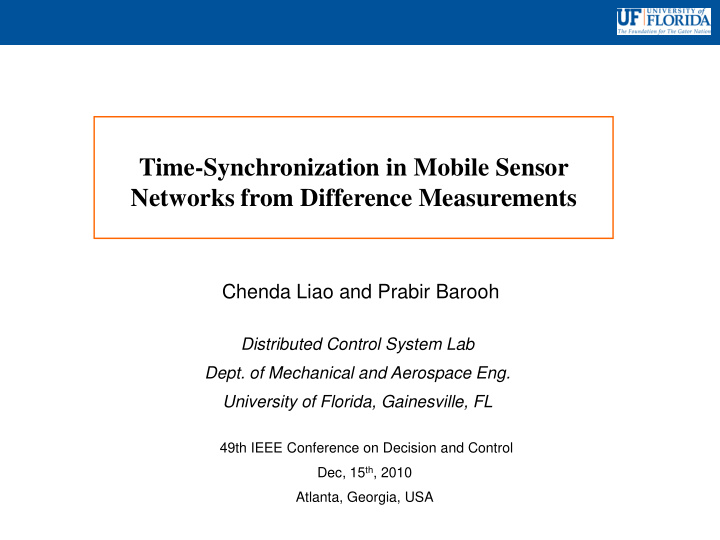



Time-Synchronization in Mobile Sensor Networks from Difference Measurements Chenda Liao and Prabir Barooh Distributed Control System Lab Dept. of Mechanical and Aerospace Eng. University of Florida, Gainesville, FL 49th IEEE Conference on Decision and Control Dec, 15 th , 2010 Atlanta, Georgia, USA
Sensor Networks • Environment/Structure Monitoring • Event/Fault Detection • Home/office Automation • Healthcare • Industrial Automation • Military Application Limited power
Time Synchronization in Sensor Network Motivation: Local time: Global time =global/reference time =local time =skew =offset Meaning of Sync. : u Time synchronization problem is equivalent v to determining and , ref
Literature review Static sensor network • Elson et al., Fine-grained network time synchronization using reference broadcasts (RBS), 2002 • Ganeriwal et al., Timing-Sync Protocol for Sensor Network (TPSN), 2003 • Barooah et al., Distributed optimal estimation from relative measurements for localization and time synchronization, 2006 • Suyong Yoon et al., Tiny-Sync: Tight Time Synchronization for Wireless Sensor Networks, 2007 Mobile sensor network • Miklós et al., Flooding Time Synchronization Protocol (FTSP), 2004 • Su et.al., Time-Diffusion Synchronization Protocol for Wireless Sensor Networks (TDP), 2005
Time Sync on Mobile Sensor Network Goal: To estimate the skews and offsets of clocks of all the nodes with respect to an reference clock in mobile sensor network. Algorithm: Network-wise synchronization: Pair-wise synchronization : Noisy measurement of the Each node estimates its offset/skew from relative skews and offsets noisy measurements by communicating for pairs of nodes only with its neighbors iteratively. • Model the time variation of the network (graph) as a Markov chain. • Prove the mean square convergence of the estimation error (Markov jump linear system). • Corroborate the predictions using Monte Carlo simulations.
Measurement Algorithm • Directly measure and ? No! • But node u can measure and . • Method: pairs of nodes exchange time-stamped packet with two rounds communication. v u Measurement Algorithm Time - stamp Noisy measurement Gaussian zero mean Details in [Technical Report] Liao et al. Time Synchronization in Mobile Sensor Networks from Relative Measurements
Relative Measurement Same formulation for relative skew and offset measurement Where Node variables Errors Noisy measurements Relative Task: measurement Estimate all of the unknown nodes Reference variables from the measurements variable =0 and the reference variables.
Distributed Algorithm for Estimation Algorithm: Similar to an algorithm in time sync of static sensor network. (e.g., Barooah et.al., 06) Where is the estimate of node variable at time k is the neighbor set of node u at time k is the number of neighbors in Example: 3 6 4 Remark: • , if for all u by using flagged initialization. • If node u has no neighbor, then .
Performance Analysis • Consider the graphs with 25 nodes, the number of different graphs is State space and • If evolution of satisfies Markovian property • can be modeled as the realization of a Markov chain. • Example An edge exists if Euclidean distance between Position pair of nodes is Projection Random less than certain function vector value.
Convergence Analysis Discrete-time Markov Jump Linear system modeling • and are governed by Markov chain, • • is W.S.S, and • and Theorem: • is entry-wise positive • At least one element of is a mean square convergent connected graph calculable Conjecture: • Markov chain is ergodic • The union of all the graphs mean square convergent in is a connected graph Proof in [Technical Report] Liao et al. Time Synchronization in Mobile Sensor Networks from Relative Measurements
Simulation (4 nodes) 4 snapshots Mean of estimates of variables of node 3 Variance of estimates of variables of node 3 Number of edges of node 3 along time Sample trajectory of estimates of node 3
Simulation (25 nodes) 4 snapshots Mean of estimates of variables of node 25 Variance of estimates of variables of node 25 Number of edges of node 25 along time Sample trajectory of estimates of node 25
Simulation for Conjecture All three possible graphs Variance of estimates of variables of node 3 Mean of estimates of variables of node 3 Number of edges of node 3 along time Sample trajectory of estimates of node 3
Summary and Future Work Summary: • A distributed time-synchronization protocol for mobile sensor networks. • Mean square convergent under certain conditions. Future work: • Weaker sufficient conditions for mean square convergence • Convergence rate in terms of the Markov chain's properties.
Thank you! This work has been supported by the National Science Foundation by Grants CNS-0931885 and ECCS-0955023.
Back up Start from here
Algorithm for Measuring Offset • Suppose , then • Goal: Measure relative clock offset • Method: Exchange time-stamped packet with a round trip. Where and are Gaussian i.i.d. random delay with mean and variance • Let denote the measurement node u can obtain and denote measurement error with mean 0 and variance • Finally, we obtain noisy measurement of relative clock offset (4)
Algorithm for Measuring Skew and Offset • Now, consider • Goal: Estimate both relative clock offset and skew • Method: Exchange time-stamped packet with two round trips.
Estimating Relative Skew • From (6), (7), (8) and (9), we obtain (10) Finally, after taking log on both side, (10) can be simplified as (11) Here, and where We make reasonably large by extending and shortening . Then, implement Taylor series, we get . Therefore, it is not hard to obtain and .
Estimating Relative Offset • Reusing first four time stamp equations, we obtain (12) Again, let and . Express (12) as Distributed Algorithm ① ②
Sphere Graph Position evolution: The projection function:
Formula of Steady State Value Let be the state space of real matrices. Let be the set of all N-sequences of real matrices The operator and is defined as follows: Let then , where and For , then and Then, let Define and
Recommend
More recommend